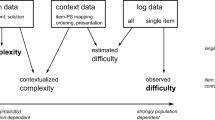Abstract
Consideration was given to the problem of estimating the levels of complexity of the test tasks for the remote education system. It was assumed that the random responses of the subjects obey the logistic distribution and the levels of student readiness are not known in advance. An algorithm based on the methods of maximum likelihood and Broyden-Fletcher-Goldfarb-Shanno was proposed to calculate the task complexity. Strict concavity of the logarithmic likelihood function was established, and an example was considered.
Similar content being viewed by others
References
Kibzun, A.I., Karolinskaya, S.N., and Shayukov, R.I., Remote Education System for Mathematical Disciplines at Universities, Vestn. Komp’yut. Inform. Tekhnol., 2006, no. 4, pp. 29–36.
Rasch, G., Probabilistic Models for some Intelligence and Attainment Tests, Chicago: Chicago Univ. Press, 1980.
Andrich, D., Rasch Models for Measurement, in Quantitative Applications in the Social Sciences, Sage Univ. Paper no. 07-068, Beverly Hills: Sage, 1988.
Bond, T.G. and Fox, Ch.M., Applying the Rasch Model: Fundamental Measurement in the Human Sciences, Mahwah, New Jersey: Lawrence Erlbaum Assoc., 2007.
Neiman, Yu.M. and Khlebnikov, V.A., Vvedenie v teoriyu modelirovaniya i parametrizatsii pedagogicheskikh testov (Introduction to the Theory of Modeling and Parametrization of Pedagogical Tests), Moscow: Prometei, 2000.
Kibzun, A.I. and Panarin, S.I., Generation of Integral Rating by Statistical Processing of the Test Results, Autom. Remote Control, 2012, vol. 73, no. 6, pp. 1029–1046.
Tronel, Zh., On Some Modifications of the Newton-KantorovichMethod, Autom. Remote Control, 1997, vol. 58, no. 10, part 1, pp. 1575–1580.
Propoi, A.I. and Pukhlikov, A.V., The Stochastic Newton Method in Nonlinear Extremal Problems, Autom. Remote Control, 1993, vol. 54, no. 4, part 1, pp. 605–613.
Nocedal, J. and Wright, S.J., Numerical Optimization, New York: Springer, 2006, 2nd ed.
Naumov, A.V. and Inozemtsev, A.O., Algorithm to Form Individual Tasks in the Remote Education Systems, Vestn. Komp’yut. Inform. Tekhnol., 2013, no. 6, pp. 35–42.
Kibzun, A.I., Vishnyakov, B.V., and Panarin, S.I., A Hull of the Remote Education System in Mathematical Courses, Vestn. Komp’yut. Inform. Tekhnol., 2008, no. 10, pp. 43–48.
Ivchenko, G.I. and Medvedev, Yu.I., Matematicheskaya statistika (Mathematical Statistics), Moscow: Vysshaya Shkola, 1984.
Polyak, B.T., Vvedenie v optimizatsiyu, Moscow: Nauka, 1983. Translated into English under the title Introduction to Optimization, New York: Optimization Software, 1987.
Bellman, R.E., Introduction to Matrix Analysis, New York: McGraw-Hill, 1960. Translated under the title Vvedenie v teoriyu matrits, Moscow: Nauka, 1969.
Author information
Authors and Affiliations
Corresponding author
Additional information
Original Russian Text © A.I. Kibzun, A.O. Inozemtsev, 2014, published in Avtomatika i Telemekhanika, 2014, No. 4, pp. 20–37.
Rights and permissions
About this article
Cite this article
Kibzun, A.I., Inozemtsev, A.O. Using the maximum likelihood method to estimate test complexity levels. Autom Remote Control 75, 607–621 (2014). https://doi.org/10.1134/S000511791404002X
Received:
Published:
Issue Date:
DOI: https://doi.org/10.1134/S000511791404002X



